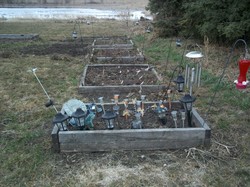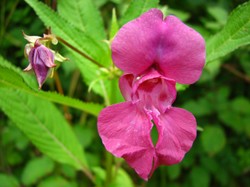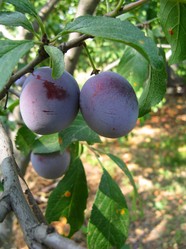Whether you are a novice gardener or a veteran, each year brings new challenges to your garden. Some years it is too dry, other years may be too wet. There are bugs to contend with (but remember, the bugs aren't all bad) and deciding what to plant each year. Changes in number of family members and/or dietary needs also plays a part in what you use your garden for each year.

Preparing Your Garden
by dziomek
Each spring there is work to be done in the garden. This article will help out with tips and tricks to making the most of it.
Step One
Cleanup
Now that the snow has melted and the weather has warmed, there are preparations needed to get your garden ready for planting. The first thing to do is to clean up any spent plants and weeds that didn't get cleaned up before the snow fell. When it comes to the weeds, be careful to try not to scatter the seeds. Placing a bag over the top and closing it around the stems will keep a lot of weed seeds out of your soil.
For those of you who have a compost pile (and you should if you're serious about gardening) the spent plants may be tossed into it. As for the weed seeds, generally the trash is a better place for them. Some weed seeds are killed by the heat compost bins produce, but if you're not sure it is best to dispose of the weeds elsewhere.
Rake your lawn and toss the grass into the compost bin as well. This will provide some of the "brown matter" every compost pile needs to keep a healthy balance. Remove any sticks or stones that may have made their way onto the lawn or into the garden beds and toss them aside, either into your fire pit or into a tote to be disposed of elsewhere. the rocks may be used in your rock garden or to fill in the holes that appeared in your driveway over the winter.
Step Two
Working the Soil
Now that you have raked and removed the weeds and dead plant matter, it is time to work your soil. The garden space itself should consist of either garden beds or paths between the planting areas. Not walking in your garden plot is advisable, as the soil doesn't get compacted. It stays loose and friable which makes for bigger and healthier vegetables and flowers.
Using a cultivating tool is best for working the soil in the garden. It is pushed into the soil and then rotated to loosen the soil. I have one that is very similar to the "Garden Claw" that many garden centers carry. I prefer to use it as it is environmentally friendly and works well in small spaces. I have a few of my garden beds marked off in one foot grids and the cultivating tool works well in each of the squares. I can also work individual areas without having to worry about disturbing nearby plants.
For those with a larger garden area to work up, a rototiller may be a more feasible option. The equipment you choose to use depends largely on your resources and garden space.
Step Three
Adding Amendments
Now that your soil is worked, it is time to add some amendments. The amendments I am referring to is generally compost. Compost will not burn your young seedlings like commercial fertilizers do. Keep in mind, with commercial fertilizers it is very important to read the label and follow directions to the letter. More is not better in this case. As for the compost, be sure it is free of any larger pieces of plant matter such as stems or husks. A screen may be made to separate your usable compost from the plant matter which hasn't broken down completely.
Spreading the compost on top of the soil is sufficient, but you may also wish to work it in. Working it in as you plant your seeds and seedlings is also sufficient. An inch or two of compost on top of your soil will encourage earthworm activity which will benefit your garden by aerating the soil. Aeration helps plants grow and develop healthy root systems.
Step Four
Planting your Garden
Now comes the fun part! Planting your seeds and seedlings. A word of advice: follow package directions! If you are unsure of how much a single plant will produce, please do your research. Gardening magazines, seed catalogs and garden centers should all have the information you require. Do not plant a whole package of zucchini seeds if you only need a couple of plants. Zucchini are great producers; you will have all of your neighbors locking their doors when they see you coming up the walk. Either that or you will quickly learn 101 Things to Make with Zucchini.
Be sure you allow sufficient space for your plants; remember they do grow quickly. You may think you haven't planted enough, but with proper growing conditions you may find yourself with an abundance of vegetables. Or worse yet, a crowded garden which does not produce well. Following planting directions minimizes thinning of plants and wasting seeds.
Step Five
Maintaining Your Garden
As the weeks go on, your garden will begin to flourish. It often seems the weeds grow faster than the flowers and vegetables, and I too believe it to be true. By mulching around your seedlings with compost you will eliminate some weed growth, as they require light to germinate. It is also important to pull weeds when they are young; waiting until they have taken a good foothold is not recommended. Pulling them when they are small gives you the option of tossing them into your compost pile, which in turn will benefit your garden soil the next growing season.
Keeping weeds in check, checking regularly for pests and watering regularly will keep your garden healthy and happy. Harvesting your fruits and vegetables in their prime ensures you receive the maximum health benefits and encourages additional production on the plant. It only takes a few moments each day to do a quick walk around your garden to check for potential threats.
Encouraging birds and bats to make their home in your garden also helps decrease your bad bug worries, as they will visit your garden daily. Gardens are planted to be enjoyed, so don't forget to enjoy yours. By taking a few simple steps you will minimize your work load so you have more time to enjoy the fruits of your labor. Put out the birdbath and hummingbird feeders; add a few solar lights; place benches throughout your garden and enjoy!
Garden Tools
 | Greenes Fence RCEC6T21B Best Value Cedar Raised Garden Bed Planter, 48" W x 96" L x 10.5" H The Greenes Fence 4'L x 8'W x 10.5"H Cedar Raised Garden Bed can have you cultivating your own variety of fun plants. Use it to grow herbs, vegetables and berries. Putting it to... Only $83.99 |
 | AeroGarden Black Harvest, 2019 Model The AeroGarden Harvest is a simple, beautifully designed garden, versatile enough to fit almost anywhere, but perfect for the best room in the house your kitchen. The Harvest is... |
 | Best Choice Products Raised Garden Bed 48x24x30-inch Elevated Wood Planter Box Stand for Backyard... Give your plants and vegetables a healthy home for growth. This raised gardening bed is designed with plenty of room for plants to grow to their full potential. The Cedar wood b... |
You might also like
Weeds Wild, Wicked and EdibleWeeds are simply plants that we do not want in our farms and gardens.
Midsummer, and a Damson in DistressAround midsummer the first planting is over and harvest is some distance away...






Comments
Last summer I let my runner beans climb my sunflower plants; dual purpose. A little note about the zucchini which I found out the hard way two years ago: do not plant zucchini and watermelon within 8 feet of one another. I had a beautiful watermelon, or so I thought. When I cut it open it was all zucchini inside; the two had cross pollinated and I ended up with more zucchini than I anticipated. The next time I plant the two, they will be on opposite ends of the acreage...lol!
Thank you! Perhaps that's why I like it too, because I used to love making mud pies.
Welcome to Wizzley! I enjoyed your gardening tips. Preparing the soil has always been my favorite part of gardening. My mom says it reminds me of my childhood days of making mud pies.